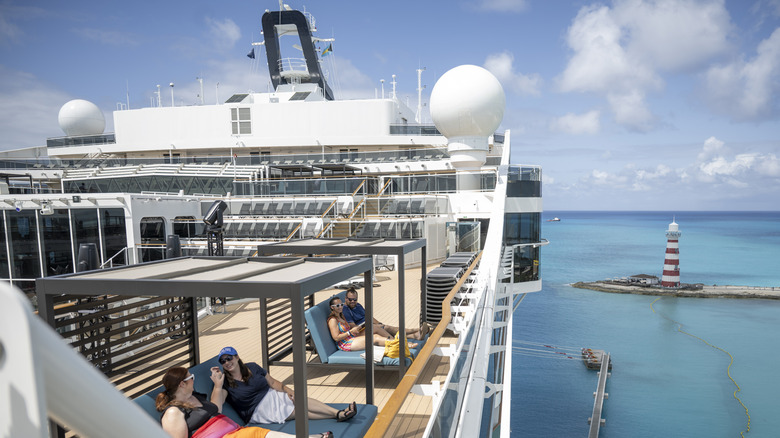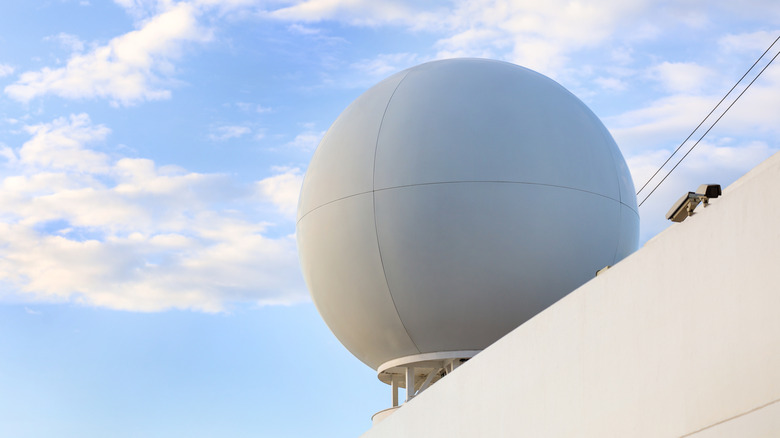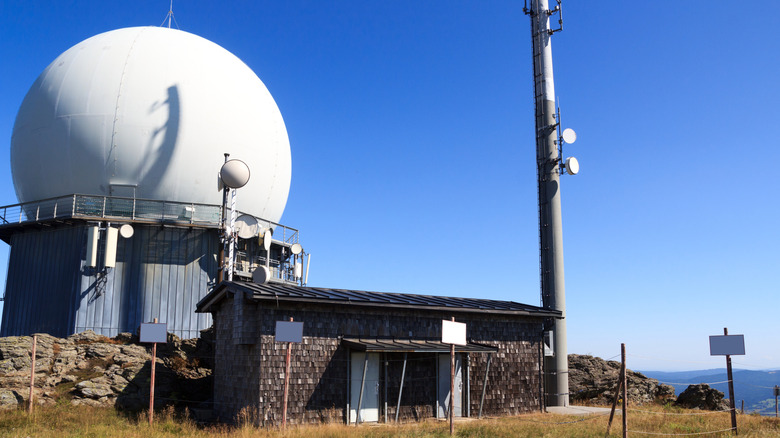What Are The Big White Balls On Top Of Cruise Ships For?
Among cruise ship heavyweights like Royal Caribbean, vessels that share a class tend to be close in size, with similar layouts and facilities. Veteran cruisers would probably have a good idea of where everything is on a new ship just through this familiarity. Even so, there are some intriguing features they may not be able to explain, regardless of how many times they've seen them. Case in point: The large white spheres on top of the vessel. They're sure to draw the eye, and at first glance, there's no telling what they are or what they do.
These balls are radomes, and they're designed to protect radar antennas and other sensitive equipment. Staff and crew members often need sophisticated radar and communications equipment to keep a cruise running on its proper course. In both cases, a lot of sophisticated equipment is required, and it must be protected while on the ocean to continue to accommodate the comfort of passengers (because it's not all about hiding rubber ducks). What appears to just be a simple white ball, then, is actually a protective layer for something very advanced. It resembles the Spaceship Earth Geosphere at Epcot, and there's potentially just as much vital technology within it. Cruise ships may not have the highest top speeds, but they're advanced vessels.
What does a radome do?
As noted, cruisers typically want to be both entertained and connected with those at home. With these needs and the high-tech functionality of cruise ships in mind, TV signals and a stable Internet connection are musts. It's not just about recreation, either, as the antenna that a radome conceals could also be crucial to satellite navigation systems or other important functionality. It also helps facilitate the passing of the signal that these systems rely on.
Radomes may have some of the most sophisticated surveillance technology within them. In and of themselves, though, they don't really do anything — they're more of a protective barrier. Radomes can be constructed from materials such as resin, carbon, and quartz, and they can be shaped and formed to best suit the surface and equipment they are required to protect. Manufacturer Saint-Gobain Aerospace notes that one method of doing so is thermoforming, which uses mold to fashion the materials into the correct size and shape. Indeed, the complexity and versatility of radomes mean that they have utility far beyond cruise ships.
Other places you'll find them
Amid the myriad of things to do and the antics of thousands of passengers, you might never have spared a thought for the radome of a cruise ship. But you've probably seen them elsewhere. The unique functionality of a radome means that it's very well suited to other vehicles that travel in challenging environments, such as aircraft.
The goal is to place them in locations that will keep them protected while maximizing the effectiveness of the radar equipment contained within them. For this reason, the radomes of aircraft will typically be placed in an area already notable for its distinctive shape: the nose. It's a functional feature, influencing the drag and reducing its negative effect, and it's also a handy little odd-shaped place for a radome to fit. This helps to explain why old airplanes had black noses. They're not always found here, though: According to the U.S. Naval Institute, the Douglas Skyraider "had a grotesque configuration with the APS-20 fitted in a large belly radome," which led to the aircraft's nickname, "Guppy."
Naturally, there are also harsh conditions here on terra firma, where radomes can be deployed. Some of the sophisticated radar equipment used in the Arctic, for instance, needs protection too, which is why facilities like the Svalbard Satellite Station's use radomes. In 2019, the station's director, Ole Petter Storstad, told the European Space Agency (ESA) that they had "about 80 tracking antennas" and "the perfect location for tracking polar-orbiting spacecraft." The antennas that monitor the satellites are, as expected, safely ensconced within radomes. There are also other facilities, big and small, all around the world, such as the one pictured above, that use radomes.


